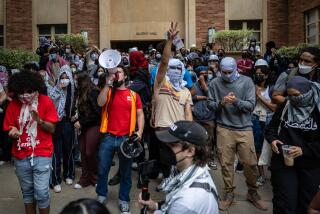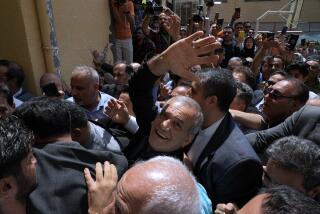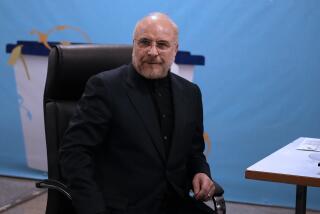Iran’s supreme leader rules out election fraud
TEHRAN — Iran’s tense capital braced for the possibility of violence after supreme leader Ayatollah Ali Khamenei demanded Friday that protesters end their mass demonstrations against alleged vote-rigging and suggested that those who defied him would be responsible for the consequences.
Khamenei, who is Iran’s highest spiritual and political leader, ordered protesters off the streets and rejected charges that President Mahmoud Ahmadinejad used fraud to win reelection last week. But the opposition was unbowed, and called on its supporters to return to the streets today.
Plans for a march at Enghelab (Revolution) Square a day after Khamenei’s forceful Friday sermon set the stage for a possible confrontation in the heart of the city.
“The way of the law is open,” Khamenei told tens of thousands of worshipers who gathered in downtown Tehran and countless others who listened on television and radio. “If people continue to take the other way, I will come back and speak more directly. . . . If they do not end it, then the consequences lie with them.
“Nothing can be changed. The presidential campaign is finished,” he declared.
At the sermon’s end, Khamenei began lamenting his physical condition and weeping, a gesture that signaled his displeasure and moved the throngs of dignitaries and Basiji militiamen gathered before him to weep in response. Observers said Khamenei’s gesture, similar to one he made during the height of 1999 student protests, was a call for loyalists to crack down on the demonstrators as a way of righting a wrong done to their patron.
The huge crowd flowed out of the Tehran University venue and into the main streets outside, roaring, “Our vote is written in blood, and we gave it to the leader.”
Ahmadinejad’s main challenger, former Prime Minister Mir-Hossein Mousavi, must now decide between his allegiance to his followers or to Iran’s unique Islamic system.
A sense of foreboding hung over the city. Shortly after Khamenei spoke, black clouds gathered and unleashed a rare late spring thunderstorm. And as darkness came, residents in many parts of the capital climbed to their rooftops and angrily shouted, “God is great!” and “Death to the dictator!” in what has become a nightly ritual of protest stemming from the widespread belief that the vote was rigged.
“The presence of people in the streets will continue, and I do hope everything will be solved in the favor of . . . [the] Iranian nation,” said Elahe Koolai, a prominent reformist and Mousavi supporter.
A text message sent to the cellphones of some people called on them to join in the march today, expected to be attended by Mousavi, reformist former President Mohammad Khatami and Mehdi Karroubi, another presidential candidate.
Analysts were not surprised by Khamenei’s tone, which defined further civil disobedience as a direct challenge to the Islamic Republic and its supreme leader, who under the constitution is held to be God’s representative on Earth.
In his sermon, Khamenei criticized some of Ahmadinejad’s conduct before the June 12 vote, and he condemned the killing of students by pro-government loyalists this week. But he came down explicitly on the side of the hard-line incumbent. He described Ahmadinejad as hard-working, and said the president’s views were closer to his than those of other politicians.
Khamenei and Ahmadinejad draw support from the same sources, including Basiji militiamen and the Revolutionary Guard.
“He cannot afford to sacrifice Ahmadinejad,” said an analyst in Tehran, who spoke on condition of anonymity. “Over the last years Khamenei has teamed up with the Revolutionary Guard to build his power. For Khamenei and the Revolutionary Guard, Ahmadinejad is the best alternative.”
Mousavi has become the head of a diverse movement that is pulling him forward as much as he’s leading it. Reformists and moderates said they feared the movement would peter out without his leadership.
“The ball is now in Mousavi’s court,” said Nader Hashemi, a professor of Middle East studies at the University of Denver. “His leadership will now be tested. Will he stand firm and continue his nonviolent resistance, or will he compromise and sell out the democratic aspirations of millions of Iranians?”
Mousavi did not immediately respond to Khamenei’s challenge.
The prime minister-turned-scholar remains under close supervision of authorities, has been denied access to state broadcasting facilities, and has seen his newspaper shut down.
“The positive aspect of this movement is that for the first time it’s everyone,” said an analyst in Tehran, who spoke on condition he not be named. “The election and the campaign [were] just an excuse to express all their problems. But on the other hand, the weakness of the movement is that it’s disorganized. The main problem is that they crystallized all their anger around Mousavi. He became a hero. But in many ways the movement is ahead of Mousavi.”
Other prominent opposition figures made calls for protesters to defy the authorities.
“We call on all the supporters of reform and change to have an overwhelming presence so that their cries are a protest at cheating and lying and backing for it at the highest levels of the system,” said a statement on Karroubi’s website.
“May the massive crowd make all officials -- who do not attach the slightest value to the people’s votes -- tremble,” the statement said.
The scene for Khamenei’s highly anticipated Friday sermon suggested that moderate figures in the Iranian establishment had been further marginalized in political infighting. Not only was Mousavi absent; so too were prominent moderates such as Ayatollah Hashemi Rafsanjani, Khatami and former Tehran Mayor Gholamhossein Karbaschi.
Ahmadinejad sat in the front row next to parliamentary speaker Ali Larijani, a conservative who is often highly critical of the president.
Mashallah Shamsolvaezin, a reformist writer and human rights activist, said Khamenei had made a political misstep by so openly allying with Ahmadinejad, and predicted that people would come out in even greater numbers because of the speech.
“If taking people into the streets is wrong, and the leader today called it strong-arming, then what is his mobilizing of people during Friday prayers?” he said. “I think the presence of the people will continue in the streets, and intimidating people is no way to solve the disputes.”
Among the young green-clad men and women who make up the heart of the movement, there was fear mixed with resilience.
The fear of bloodshed has failed to stop previous rallies. According to a count taken by a Western embassy in Tehran, at least 33 people in the capital and as many as 100 nationwide have been killed in violence between protesters and club-wielding Basiji and Ansar-e Hezbollah militiamen over the last week, including students killed in their sleep. One analyst said that protests in the cities of Tabriz, Esfahan, Shiraz and Kermanshah had already been crushed.
Amnesty International issued a bulletin describing Khamenei’s speech as giving “a green light to security forces to violently handle protesters exercising their right to demonstrate and express their views.”
One 29-year-old woman, sobbing with dismay at Khamenei’s tone, said she would nevertheless gather her courage and attend the march.
“This is how countries that have freedom and democracy get it,” said the woman, who asked that her name not be published. “They have to fight and die for it.”
--
Mostaghim is a special correspondent.
More to Read
Sign up for Essential California
The most important California stories and recommendations in your inbox every morning.
You may occasionally receive promotional content from the Los Angeles Times.










